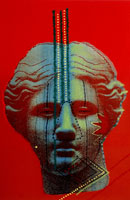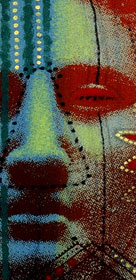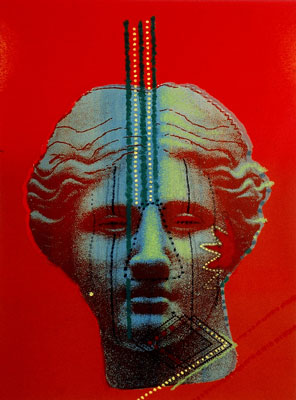|
|
STUDIO-f |
WHO ARE WE? |
COLLECTION |
ARTISTS
MAXWELL TAYLOR
SEDRICK HUCKABY
WILLIAM VILLALONGO
ROBERT ZAKANITCH
CAROL MICKETT & ROBERT STACKHOUSE
LOUISA CHASE
AUDREY FLACK
SAM GILLIAM
STEPHEN GREENE
WILLY HEEKS
ROBERTO JUAREZ
TOM LIEBER
JAMES McGARRELL
VITALY KOMAR & ALEXANDER MELAMID
SAM MESSER
ED PASCHKE
PEDRO PEREZ
LARRY POONS
KATHERINE PORTER
MIRIAM SCHAPIRO
JOYCE J SCOTT
HOLLIS SIGLER
JOHN WALKER
|
PREVIOUS SHOWS
SAM GILLIAM
|
MAP |
UTARTS |
UT
|

|
 The Chicago Sun Times, called Paschke the most acclaimed of all the Chicago Imagists whose irreverent paintings terrorized the 'good taste' of the city's art establishment during the late 1960's and early 1970's.
The Chicago Sun Times, called Paschke the most acclaimed of all the Chicago Imagists whose irreverent paintings terrorized the 'good taste' of the city's art establishment during the late 1960's and early 1970's.
Paschke created outlandish works of Pop Art, breaking through with the Chicago Imagists (a figurative movement of the 60's). Paschke studied at the School of the Art Institute of Chicago and taught for 27 years at Northwestern University, Evanston, Ill. connecting the line between Andy Warhol, who was a major influence, and Jeff Koons. Paschke rendered images from popular culture in garish fluorescent colors and the staticky lines of electronic video.
Paschke achieved a level of celebrity in Chicago, rare for any artist, in which he was often recognized on the street. He even appeared on a 50 foot billboard alongside Michael Jordan, the city's most famous resident. For someone that had suffered through years of intense shyness as a youth it was compelling metamorphosis.
Paschke's work is in public collections throughout the country, including the Museum of Modern Art, the Whitney and the Metropolitan Museum, New York City; the Hirschhorn and the Smithsonian, Wash. D.C.; The Art Institute of Chicago and the Baltimore Museum of Art, Maryland. International collections that include his work are Centre Georges Pompidou, Musee national d'art moderne, Paris, Museo de Arte Contemporaraneo de Monterry, Mexico, Musee d'art moderne et contemporain de Strasbourg, Museum Boymans-van Beuningen, Rotterdam, and Museum des 20 Jahrhunderts, Vienna.
Paschke's work defies time - classical notions and history and time are a compression of the past, present and future. He works the human face into masks, clouding features, confusing the face's gender, adding tattoos and vibrant coloring. The body of work produced in STUDIO-f in February 1999 entitled Tampa Series incorporates classical facial beauty of the Venus head and integrates primitive mask making coloring. Returning to STUDIO-f in 2001, Paschke used the Egyptian Sphinx for the Pharaoh series.
Paschke died Thanksgiving day, 2004. One year after his death, Paschke became one of the select few Chicago residents to have a street named after him, and not just any street. But rather Monroe Street between Michigan Avenue and Columbus Drive, which divides the Art Institute of Chicago which played such an intricate part of Paschke's development as an artist, and Millennium Park, a newly built area which has come to symbolize the visual arts in Chicago.

|

